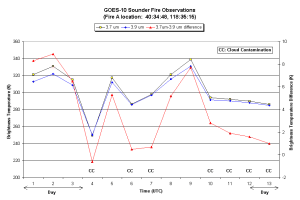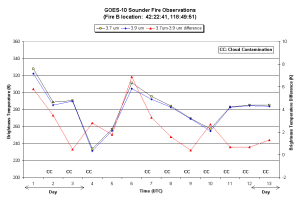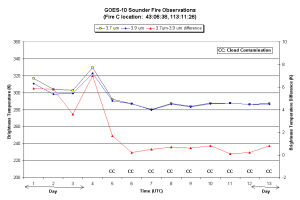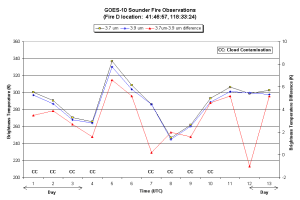| Animation GOES-10 imager observations |
Animation GOES-10 sounder observations |
| Animation GOES-10 imager observations |
Animation GOES-10 sounder observations |
On Wednesday, August 4, 1999 lightning strikes ignited numerous wildfires throughout Nevada. The largest wildfire complexes were located near the towns of Reno, Winnemucca, and Battle Mountain, Nevada resulting in temporary closures of Interstate 80 on Thursday and Friday. Large wildfires were also reported in Idaho, Oregon, California, and Montana. By Thursday evening, the Mule Butte fire in Idaho burned over 90,000 acres. August 5 loops of GOES-10 imager 3.9 micron data identified many fire complexes in Nevada, Oregon, and Idaho. GOES-10 3.75 and 3.98 micron sounder data also provided observations of some of the larger fires. The Java animations of GOES-10 imager and sounder imagery (shown above) depict the diurnal variability in the fire signatures.
The following time series compare the sounder 3.75 and 3.98 micron fire brightness temperatures and 3.75 minus 3.98 micron differences for four fires identified with the sounder imager (A, B, C, and D). In non-cloudy situations the 3.75 micron brightness temperatures are typically higher than the 3.98 values. During the daytime, this is due in part to increased solar contribution in the 3.75 micron band. During the night, in the non-cloudy situations, fire brightness temperature observations are typically higher in the 3.75 micron imagery, due in part to the increased sensitivity of the 3.75 micron band to sub-pixel hot spots.
 |
 |
 |
 |
Address any questions or comments to the GOES WebMasters